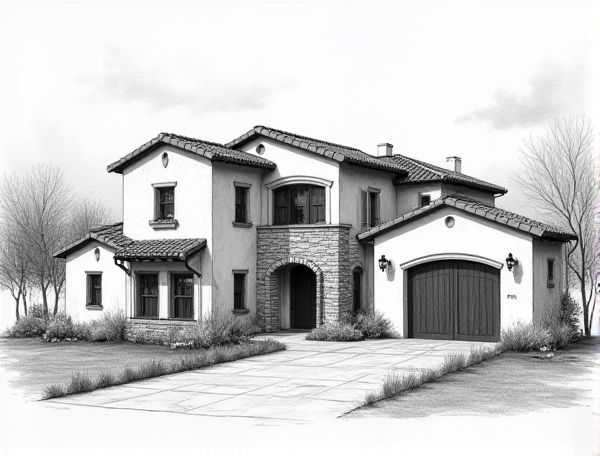
Photo illustration: Mediterranean home design with Catalan vaulted ceilings
Mediterranean home design with Catalan vaulted ceilings creates a timeless ambiance by combining elegant curves and rustic textures that enhance natural light and airflow in Your living spaces. Discover the charm and structural beauty of this architectural feature by reading more in the article.
Introduction to Mediterranean Home Design
Mediterranean home design features stucco walls, terracotta roof tiles, arched doorways, and wrought-iron details that evoke the coastal charm of Southern Europe. Interior spaces emphasize open layouts, natural materials like wood and stone, and warm color palettes inspired by sun-soaked landscapes and ocean hues.
The Timeless Appeal of Catalan Vaulted Ceilings
Catalan vaulted ceilings, characterized by their elegant curved brickwork, create an enduring architectural feature that enhances both the aesthetic and structural integrity of living spaces. Their warmth and texture infuse homes with Mediterranean charm, boosting property value while offering superior acoustics and natural insulation.
Historical Origins of the Catalan Vault
The Catalan vault, also known as the timbrel vault, originated in the Catalonia region of Spain during the Romanesque period and gained prominence in the late 19th and early 20th centuries. This architectural technique employs thin, interlocking bricks laid flat in a herringbone pattern, creating lightweight and strong curved surfaces without extensive formwork. Its historical use by architects like Antoni Gaudi has influenced modern home design by combining structural efficiency with aesthetic appeal.
Architectural Elements of Mediterranean Interiors
Mediterranean interiors feature distinctive architectural elements such as exposed wooden beams, arched doorways, and terracotta tile flooring that evoke a warm, rustic ambiance. Textured plaster walls, wrought iron accents, and large windows with wooden shutters enhance natural light and create an inviting, airy atmosphere characteristic of coastal Mediterranean homes.
Materials Commonly Used in Catalan Vaulted Ceilings
Traditional Catalan vaulted ceilings primarily utilize thin brick or terracotta tiles arranged in a herringbone pattern, supported by layers of mortar and reinforced with iron ties. Lime-based mortar is commonly employed for its breathability and flexibility, ensuring durability and resistance to moisture. Wood beams and metal rods often provide structural support, seamlessly blending strength with the vaulted ceiling's characteristic lightweight design.
Benefits of Incorporating Vaulted Ceilings
Vaulted ceilings enhance your home's sense of space by creating an open, airy atmosphere that increases natural light and ventilation. This architectural feature can also improve energy efficiency by promoting better airflow, potentially reducing heating and cooling costs. Incorporating vaulted ceilings adds aesthetic value and a luxurious feel, making your living areas more visually appealing and inviting.
Integrating Natural Light and Open Spaces
Maximizing natural light through strategically placed windows and skylights enhances energy efficiency and creates a warm, inviting atmosphere in home design. Open floor plans complement this by promoting a seamless flow between rooms, increasing the perception of spaciousness and encouraging natural ventilation.
Color Palettes and Textures in Mediterranean Design
Mediterranean design emphasizes warm, earthy color palettes such as terracotta, ochre, and cobalt blue, paired with natural textures like stucco walls, wrought iron, and rustic wood to create an inviting, sun-soaked ambiance. Incorporating mosaic tiles, textured ceramics, and layered textiles enhances the tactile richness and authentic aesthetic of Mediterranean interiors.
Decorating Tips for Homes with Catalan Vaults
Enhance the unique curves of Catalan vaults by incorporating warm, natural materials such as terracotta tiles and exposed wooden beams to complement their historic charm. Your decor should emphasize soft, ambient lighting and minimalist furnishings that allow these architectural elements to remain the focal point of the space.
Combining Modern and Traditional Mediterranean Styles
Blending modern and traditional Mediterranean styles enhances home design by integrating sleek, minimalist elements with rustic textures such as terracotta tiles, wrought iron fixtures, and warm, earthy tones. This fusion creates a balanced aesthetic that emphasizes natural light, open spaces, and handcrafted details inspired by coastal villas and historic Mediterranean architecture.
 homedesy.com
homedesy.com